No Pills? No Surgery? No Problem.
Eliminate Pain Without MedicationPhysical therapists can help reduce and manage many types of pain, including low back pain, which affects up to 80 percent of Americans during their lifetime. Allowing a Physical Therapist to mobilizes the spine along with specifically prescribed exercises can help alleviate the pain and can have long-lasting effects.
1 If you are at risk of heart disease, the American Heart Association encourages seeing a physical therapist for the initial treatment of pain resulting from tendinitis/bursitis, degenerative joint problems (osteoarthritis), and inflammatory joint problems (rheumatoid arthritis), rather than prescription pain medication. 2 Our Physical Therapists are a great alternative to medication and surgery for musculoskeletal pain. Research shows individuals who receive active physical therapy experience greater improvement in function and decreased pain intensity. 3 No matter what part of your body hurts, our Physical Therapists at First Choice Physical Therapy can help you alleviate or manage pain without costly medication or other invasive methods, in many cases. 4 Speaking of pain-had any non painful surgeries lately? Physical therapists can help you avoid painful, invasive and expensive surgery, in many instances.
Research shows that Physical Therapists, combined with comprehensive medical management, are just as effective as surgery when it comes to relieving the pain and stiffness of moderate to severe osteoarthritis of the knee, low back pain and many other common areas of pain. 5 Pursuing an exercise program designed specifically by a Physical Therapist can be one of the best protections from injury and surgery. Explore the many ways in which our Physical Therapists at First Choice Physical Therapy can help you improve your mobility.
As always, First Choice Physical Therapy is here to help. Our desire is to get you better without pills and without painful surgeries. Over the past 12 years we have helped tens of thousands alleviate pain and avoid surgery. What are you waiting for? Call today to let one of our highly skilled, trained and caring Doctors of Physical Therapy evaluate you today. Two locations to PAGE 2serve you-Lynn Haven and our Newest Location on Panama City Beach in the Grand Panama Village.
To your Health,
Dr. Wade M. Rinehart
Doctor of Physical Therapy
First Choice Physical Therapy
“Our PhysicalTherapists are a great alternative to medication and surgery for musculoskeletal pain.”
Dr. Wade Rinehart
Excerpts of this article taken from the APTA website and the following Journals:
1 Spine, July 2008
2 Circulation, February 2007
3 Spine, July 2008
4 Spine, July 2008
5 New England Journal of Medicine September, 2008
How To Have A Pain-Free New Year
It’s that time of the year again; the Holiday season is ending, and a New Year begins! Which means you may have traveled to see family, climbed up into the attic to put up the Christmas decorations, and inevitably lifted heavy luggage and presents. The latter may cause a great new year to become a nightmare with a terrible back injury. We often see patients with back pain from lifting luggage or boxes awkwardly and feeling immediate discomfort in their low back.
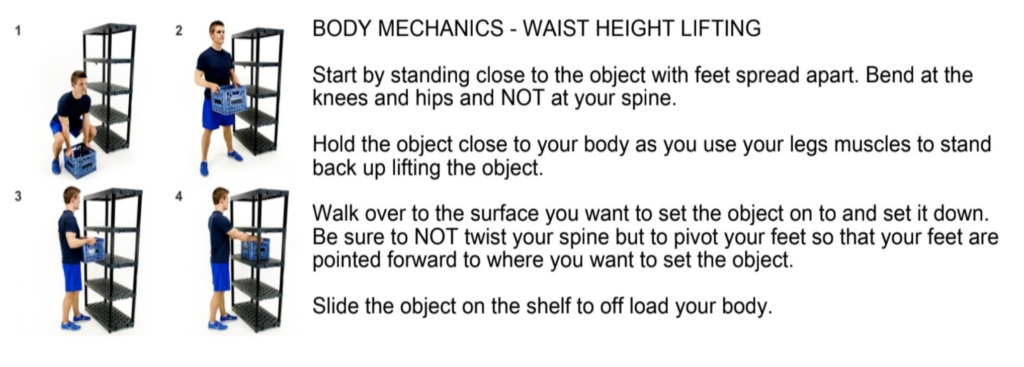
Maybe your back pain is not from lifting something awkwardly but from sleeping on a relative’s uncomfortable guest bed while visiting them for Christmas. Either way, chronic back pain is something that none of us want to deal with in the new year! Using proper body mechanics such as hinging at the hips and keeping your spine braced is a great trick to avoid back pain-You know, the whole lift with your legs thing! Another great piece of advice is to set aside the ego and get someone to help you with the lift.
Sleeping in an uncomfortable bed can also cause a lot of pain and discomfort, especially in the low back. One way to avoid awkward sleeping conditions is to sleep with a “neutral” spine. Make sure you are sleeping on your side or your back to help maintain a proper spinal alignment. Adding a pillion between your legs while on your side or sleeping with a pillow under your legs while lying on your back will also help take the pressure off of your spine. Try to avoid sleeping on your stomach, which can cause issues up and down your spine, specifically in your neck.
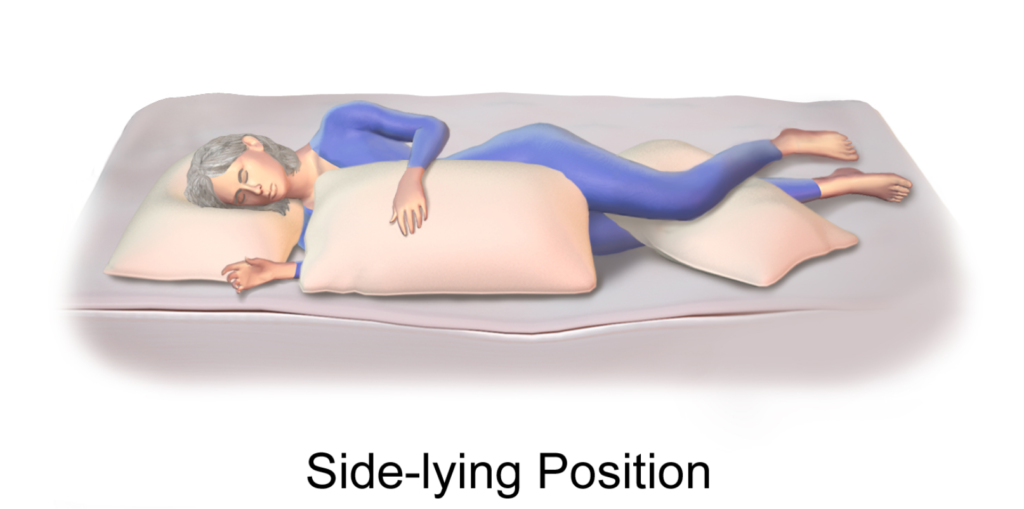
Our Doctors and staff at First Choice Physical Therapy want to wish you and your family a very Happy & Healthy New Year. We have two locations to serve you—one in town and the other on the beach. Keep an eye out for our third clinic coming in January of 2022. If we can help you with any of the problems mentioned above just give us a call at 850-248-1600 today!
Fall Prevention and Decreasing Risk Factors
Five ways to prevent falls in your home:
Do you have someone living in your home at risk of falling? Here are some tips to prevent falls and secure your home for your loved ones!
- Remove loose carpeting or tack down with tape around all edges – this includes area rugs, entryway rugs, etc
- Run cords along walls. If cords must go along a walkway, tape to floor to prevent catching a foot or assistive device (walkers, canes…)
- Install railings at steps and stairs
- Keep clutter off of floors and walkways
- Be aware of pets when walking around, securing in another room if necessary
If you are concerned for yourself or a loved one who is at risk for falling, come see us for a fall risk assessment. We will provide you the tools to
increase your strength, balance, and confidence – all necessary to prevent falls and keep you healthy!
Dry Needling Can Help
Dry needling has been around for decades in the United States and used by various professionals, including physical therapists. Around the world, these techniques have been utilized for much longer and have scientific research to substantiate their effectiveness as a treatment method for pain control and restoring muscle function. After a decade-long battle with the state of Florida by our founder Dr. Wade Rinehart and fellow colleague, Dr. Rob Stanborough, dry needling was approved in 2020 to be utilized by credentialed and trained Doctors of Physical Therapy.
Dry needling is the penetration of soft tissue trigger points with a thin needle that elicits a twitch response. Trigger points (TRPs) are caused by a cascade of things that ultimately causes pain by starving the muscle of oxygen and necessary nutrients. This leads to impaired muscle function, preventing it from contracting/relaxing properly, which in turn creates poor movement patterns, loss of motion, or even weakness. The presence of TRP’s can place more stress on other surrounding muscles as they pick up the slack of the impaired muscle, leading to TRPs becoming present in these muscles as well. Additionally, due to the poor muscle function, surrounding muscles working together to perform coupled movements fall short of stabilizing our joints throughout the activity, leading to joint pain.
Dry needling is also proven effective for treating chronic regional pain syndrome (CRPS) and fibromyalgia. These diseases are associated with chronic pain and are often unexplained. It is common to have multiple points of pain in many regions of the muscles and joints in these diseases. Our bodies detect taste, smell, hot, cold, and pain via the central nervous system (CNS) via the spinal cord. With fibromyalgia and CRPS, this pathway can become flooded with input from pain from various parts of the body. Normal signals like a sheet brushing up against your foot are perceived as pain. The cause of this pain is often associated with the presence of TRPs. Just as nerves can cause pain in other body regions, TRPs can have the same effect. For example, TRPs in the upper trapezius muscle can cause headaches and shoulder pain. TRPs in the cervical spine musculature can cause headaches and decreased range of motion in the neck.
At First Choice Physical Therapy, we have the ONLY expertly trained doctors of physical therapy in the Panhandle. These techniques have been vetted and proven repeatedly to be very effective and completely safe for treating the above conditions. If you suffer from CRPS, fibromyalgia, headaches, muscle aches/pains, or joint pain, let our doctors identify the root cause of your problem to help improve your quality of life. We now have three clinics to serve you- Lynn Haven/Panama City, Callaway, and Panama City Beach. Call now 850-248-1600 and let us help you today!
The “Core” of Your Back Pain
The phrase” you’ve gotta work your core” is frequently misinterpreted. We hear this from our doctors, our trainers, and sometimes our friends regarding treating or dealing with lower back pain. Let us first define core as the central, most important part of something. The misinterpreted portion of that phrase is the word core, as it is thought to be the anterior core musculature, particularly your abs. This is only partially true! Our core musculature fully wraps around our torso and forms a type of stability blanket around our internal organs and spine. It provides a central anchoring system for our limbs to move and manipulate objects in space. The deeper posterior and lateral core musculature is most responsible for stabilizing the spine and helps to prevent low back injuries from occurring in the first place.
Low back pain can have many origins, but disc injury is one of the most serious. In disc injuries, compression of the nerve roots can occur, resulting in localized inflammation and pain that can refer to the buttocks or the leg. Even the best-trained core can sustain a disc injury due to poor lifting mechanics or movement patterns. However, the chances of injury go down as your core function goes up. In sports such as soccer, volleyball, and baseball, the core is used to stabilize the body’s center, so kicking, serving, and throwing can occur. Without a sufficiently trained core, we can fall into poor movement patterns resulting in increased risk for knee, hip, elbow, and shoulder injuries. This causes us to use muscles improperly to make up the difference for force production, resulting in more injuries over time.
The take-home is that your core plays a vital role in injury prevention locally at the spine and globally with our extremities. At First Choice, we can help improve your resiliency to injury by providing you with the tools to achieve and maintain a stronger, more functional core. It is often the center from which we begin to rehabilitate our low back pain patients and is the focus of prevention for our athletic population. Give us a call to schedule an appointment with one of our Doctors of Physical Therapy 850-248-1600.
Conquer the Day
Matthew 6:25-34, Jesus teaches us about not worrying and to not be anxious about anything. Scripture tells us to focus on today and today only, tomorrow will take care of itself. Controlling what we can control and making the best of today, will help with your overall health, mood, and protection from illness. Yes, be informed. Yes, be careful and safe. Yes, take necessary precautions right now but we also must remember that our mind and emotional state both have a huge effect on how our physical body responds. Get out in the sunshine, play outside with your kids, exercise at home, stay hydrated with constant water intake and remember that this is only a season of our life. There is a time coming when COVID-19 will be behind us and we will all be stronger.
Exercise and proper nutrition are great ways to stay healthy and improve overall metabolic health. Choose today to eat healthier, drink more water, get more exercise and practice positive things in our life that will help physically and emotionally. All of us at First Choice Physical Therapy are here to help you. We are open and essential. If you need to make an appointment with us we are here to help. We are also here if you have any questions regarding home exercise programs. If you had an upcoming surgery canceled, contact us if you have any questions on what to do to prepare for the surgery once that time comes. These are not common times, but we are not common people. Stay strong, stay positive, stay in constant prayer with the Heavenly Father and know that we are all going to get through this.
Brannon Chester, DPT
Doctor of Physical Therapy
Fixing Lower Crossed Syndrome
What is Lower Crossed Syndrome?
Lower crossed syndrome is a common abnormal posture associated with muscle imbalances in the lower body. This muscle imbalance consists of some weak/lengthened muscles (ie. the abdominals as well as the glutes) and some tight/over-developed muscles (ie. the lower back muscles and hip flexors).
What causes lower crossed syndrome?
There are several causes of lower crossed syndrome, including poor posture and suboptimal training that can lead to muscle imbalances. A sedentary lifestyle can cause the hip flexors to remain in a shortened position for long periods of time, which can lead to tightness. When you aren’t as active, your glutes and abdominal muscles also won’t be challenged, which may lead to weakness in these muscles. Even if you are active, overworking the hip flexor muscles or lower back muscles can also cause this imbalance.
How do you fix lower crossed syndrome?
In order to fix lower crossed syndrome, you have to address the muscle imbalance. To do this, you will need to strengthen the glutes, which pull the backside of the pelvis downwards. You’ll also want to strengthen the abdominals to help pull the frontside of the pelvis upwards. But that is just half of it. You’ll also want to stretch the tight muscles. This includes the lower back muscles and the hip flexors as mentioned above. Listed below are a few exercises that can help correct this poor posture. Come into First Choice Physical Therapy for proper instruction with each of these exercises!
- Lower Trunk Rotations
- Half-Kneeling Hip Flexor Stretch
- Single Leg Bridges
- Bird Dogs
- Pallof Press
Dr. Ryan Bohn, PT, DPT
John Bates
“Dr. John!
Thank you for your help. I needed someone who could scale to my strengths and weaknesses and you were able to work me through it. Even when I needed to step back. I appreciate you!
Thanks again, John Bates”
Bike Fitting to Prevent Injury
Being properly fitted to your road bike will not only make your ride more comfortable, but it will also help you maximize your efficiency, increase your speed, and most importantly prevent injury. Here are a few fundamental things to check out the next time you hop on the bike to make sure you have the best fit on your ride!
Frame Size: When standing over the bike, the top tube should be about one to two inches away from your crotch.
Seat Height: At the bottom of your pedal stroke there should just be a slight bend in your knee. There is some trial and error in finding the perfect seat height. If the seat is too high, you might feel your hips rocking while pedaling. If the seat is too low, you may start to feel some pain in your knees.
Seat Position: You will also want to check to make sure your seat isn’t too far forward or backward. To determine this, take a look at where your knee cap is when your cranks are parallel with the ground. The knee cap should be directly over the ball of your foot in this position.
Handlebar Position: The handlebars should be set to a position where your torso makes about a 45-degree angle and your arms form a 90-degree angle with your torso. However, some riders are all about maximizing speed and are willing to sacrifice a little discomfort to achieve this. Whereas other riders would rather be a little slower if it means they can be more comfortable on the bike. This can and definitely should be adjusted accordingly. The angle of the torse will be less if you are trying to be a little more aerodynamic and the opposite is true if you are looking for a more comfortable ride. Sometimes a different stem is necessary to achieve the perfect position for you.
Dr. Ryan Bohn, PT, DPT
Top 3 Exercises to Prevent Wakeboarding Injuries
Whether you are a beginner, intermediate, or a professional wakeboarder, participating in this sport definitely requires a lot of balance. Lacking balance out on the water can potentially lead to serious injury and emphasizing balance training should be a priority for all wakeboarders. Listed below are three exercises that can help take your wakeboarding skills to the next level and more importantly, minimize the major wipeouts that can leave you injured instead of ripping it up behind the boat. But before you try these exercises out, schedule an appointment at First Choice to make sure these are right for you!
Bird Dogs. This exercise will strengthen both the glutes as well as the core musculature, which are key muscles when developing a solid foundation and optimizing your balance. To perform this exercise you will start in the quadruped position (on your hands and knees). You are going to want to maintain a neutral spine throughout this exercise, so make sure to tighten up your core by engaging the abs. Next, you will kick one leg straight back and at the same time, raise your opposite arm. Pause at the top of this movement and then lower both your arm and leg. Perform 15 repetitions on one side and then switch to the other side.
Bosu Ball Squats. Looking for a little more air? Strengthening the quadriceps muscles will give you that extra “pop” off the top of the wake and give you that major hang time you need to land your latest trick. Once you are standing on the ball, bring your legs about shoulder-width apart. Begin the squat by bringing your hips back like you are sitting down in a chair. Pause at the bottom of the squat and then simply stand back up while making sure your knees are in line with the direction of your feet.
Single-Leg Bridges. Cutting hard into the wake requires a powerful hip drive. This glute strengthening exercise will help maximize your speed coming into the wake, setting you up for some major air. Start this exercise by lying down on your back with both knees bent up and your feet flat on the mat. Now straighten out one leg so your leg is just slightly higher than your other knee. Engage the glutes and drive your hips up. Pause at the top and then slowly lower your hips back to the mat.
Staying Healthy and in Shape at Home During Isolation…
If you’re like me, working out and being able to lift weights is much more than just picking a weight up and putting it down. It relieves stress, keeps your body weight down and most importantly for me decreases mental fatigue and gives you an outlet. With all of the gyms closed, for now, you might be missing the euphoric feeling that you get from working out but do not worry, there are things you can do at home with bodyweight and a little creativity that will help keep you in shape and mentally strong!
Simple bodyweight exercises such as air squats, lunges, push-ups, and pull-ups are a great way to get your heart pumping and hit all of the major muscle groups. A way to mix it up and include your pets is for every time you throw the ball for your pup, you perform 10 push-ups while they are bringing it back to you. Challenge yourself and your pet to see who gives up first. Spoiler alert: you will lose! I challenged my chocolate lab and after 10 sets I was throwing in the towel and he was just getting his 4 legs loose.
It is important in these uncertain times that we do something for our mental well being. Turn off the news, turn off social media, put the phone down and get a workout in whether it be in your garage, back yard or go on a walk and have some quiet prayer time. Stress and worry are thieves to happiness and both mental and physical well being. Control what we can control and that starts with our health.
First Choice Physical Therapy is committed to not only the physical well being of our patients but also the mental and emotional well being of our patients. We are doing all we can during this time to make sure all of our patients and staff are safe while we continue to provide essential and necessary care to everyone. We are also committed to promoting and teaching healthy lifestyles at home. If you need suggestions on what to do at home for a safe and effective exercise plan then please feel free to email one of our therapists for help.
Brannon Chester, DPT
Doctor of Physical Therapy
First Choice Physical Therapy
Upper Crossed Syndrome
What is upper crossed syndrome?
Upper crossed syndrome is a common abnormal posture associated with muscle imbalances in the upper body. This muscle imbalance consists of some weak/lengthened muscles (ie. the deep cervical flexor muscles and the lower trapezius) and some tight/over-developed muscles (ie. the pectorals or chest muscles and some of the muscles in the back of the neck including the upper trapezius and levator scapulae and cervical).
What causes upper crossed syndrome?
There are several causes of upper crossed syndrome, but one of the most common is from poor posture while sitting at a computer or looking down at your phone. Over time, this can cause the muscle imbalance that leads to the rounding of the shoulders and forward head posture, where the head is shifted forward.
What is the ideal posture of the head and neck area?
When looking at the ideal posture in the sagittal plane (from the side) of someone standing up, one should be able to draw an imaginary line going down the external auditory meatus (AKA the ear canal) through the midline of the shoulder.¹
How do you fix upper crossed syndrome?
In order to fix upper crossed syndrome, you have to address the muscle imbalance. To do this, you will need to strengthen the deep cervical muscles and lower trapezius and other periscapular musculature. You’ll also need to stretch the pectorals, upper trapezius, and levator scapulae. Listed below are a few exercises that can help correct this poor posture. Come in to First Choice Physical Therapy for proper instruction with each of these exercises!
Chin tucks
- Doorway stretch
- Prone IYT’s
- Rows
- Upper trapezius stretch
- Levator scapulae stretch
Call today, and let’s get your problem solved! 850-248-1600 – Dr. Ryan Bohn, DPT
References:
- Harrison, A. L., Barry-Greb, T., & Wojtowicz, G. (1996). Clinical Measurement of Head and Shoulder Posture Variables. Journal of Orthopaedic & Sports Physical Therapy, 23(6), 353–361. doi: 10.2519/jospt.1996.23.6.353
- Upper Crossed Syndrome. (n.d.). [Photograph]. Retrieved from https://images.app.goo.gl/Df3D6G9psvGqHMeP6

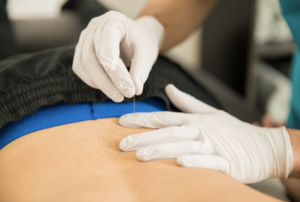
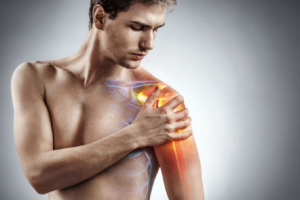
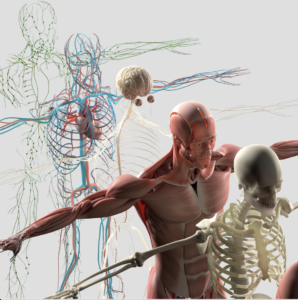
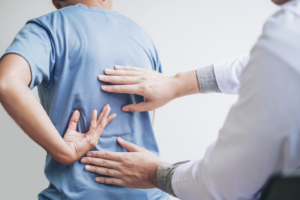
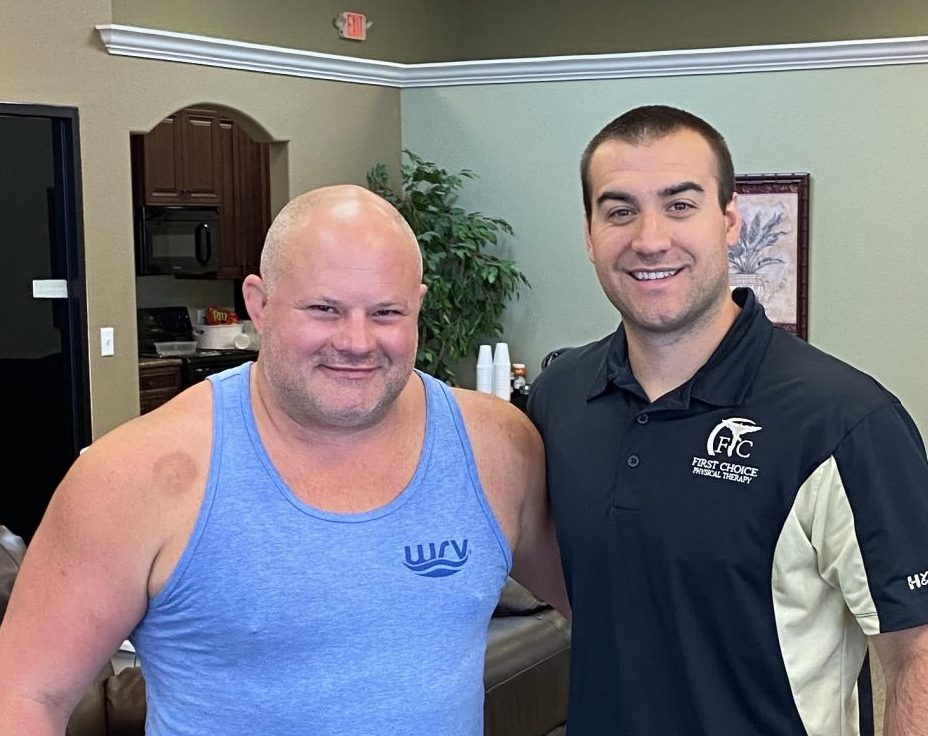
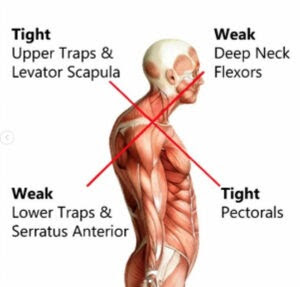 Chin tucks
Chin tucks